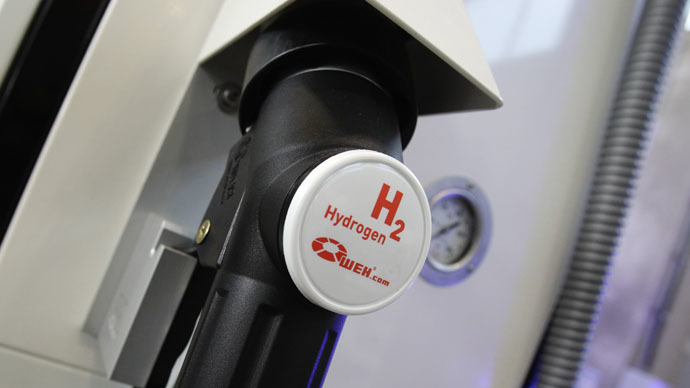Cheap, fast & pure: Breakthrough method for hydrogen fuel may revolutionize car industry

Scientists at Virginia Tech have come up with a brand new way to create hydrogen fuel: It’s cheap, fast and produces clean results, and involves plain old corn stalks, cobs and husks.
It’s long been known that the use of hydrogen has a tremendous potential both, for increasing energy efficiency and for greatly reducing greenhouse gas emissions. But as the Virginia team write in their study, published on the journal Proceedings of the National Academy of Sciences, “producing it in a distributed, carbon-neutral, low-cost manner requires new technologies.”
“Our new process could help end our dependence on fossil fuels,” Percival Zhang, an associate professor of biological systems engineering in the College of Agriculture and Life Sciences and the College of Engineering, explained in a statement. “Hydrogen is one of the most important biofuels of the future.”
READ MORE: Pollution no more? Electric cars could cut oil imports by 40% – study
Zhang and his team have already received the grant for the next
phase of the research, which is to outline methods for mass
production.
This is where the world’s simplest sugar comes in: xylose. The
resulting amounts of hydrogen in the study were possible
previously only in theory.
The method for production proposed by the Virginia Tech
scientists releases barely any greenhouse gases and does not
involve heavy metals. It also relies exclusively on processed
sugars. The dirty biomass of corn stover is also a bonus as the
fuel will have become readily available fresh out of the
processing plants. This means it would be possible to make the
sale of such fuel a local enterprise.
"We have demonstrated the most important step toward a
hydrogen economy - producing distributed and affordable green
hydrogen from local biomass resources," Zhang says.
Joe Rollin, lead author on the paper, Zhang’s former doctoral
student and co-founder with Zhang of the start-up Cell-free
Bioinnovations, created a complex multi-step algorithm describing
the breakdown of corn stover into hydrogen and carbon dioxide.
His model also allows for glucose to be used alongside xylose
simultaneously, further increasing the rate of production. This
fact was also not possible before.
The above achieves a three-fold increase in the rate of
production, as well as greatly reduces the size of the facility
required for such a production – to about the size of a gas
station – and, most importantly, does not use natural gases,
which would entail further distribution costs and most certainly
be bad for the environment.

Rollin’s model is also brilliant in that it generates ultra-pure
hydrogen, which is the stuff used in fuel cell vehicles. "We
believe this exciting technology has the potential to enable the
widespread use of hydrogen fuel cell vehicles around the world
and displace fossil fuels," Rollin says.
Xylose is key here, as it splits water molecules, in turn
producing higher purity stuff.
Though a complex process, the energy efficiency of this approach
is 100 percent. By contrast, other sugar-based processes for
biofuel generation – ethanol and butanol – can’t touch these
figures.
Zhang’s previous research, on which Rollin’s model is built, used
starch to produce the resulting hydrogen, but the process was too
costly for mass production. The current technique covers all the
bases required to start thinking big.
“It really doesn’t make sense to use non-renewable natural
resources to produce hydrogen,” Zhang says, “We think
this discovery is a game-changer in the world of alternative
energy.”
The world has been looking for decades for a way to wean itself
off of dirty energy dependency and high fuel costs. The idea to
use hydrogen has long been in the making. The US Department of
Energy has admitted that a clean hydrogen fuel could dramatically
alter our lifestyles.
Are alternatively-powered cars a futuristic, utopian concept for
now? Not at all. There were plenty of examples at this year’s
North American Auto Show of car makers boldly stepping into new
terrain with myriad new technologies – hydrogen-based fuel among
them. Check out Honda’s Fuel Cell Vehicle (FCV), slated for
production in 2016.
READ MORE: 10 cars that bend the rules at the
Detroit Auto Show
But the scientists need to hurry. The market for electric cars is
likewise on the rise. So much so it could cut fuel costs by 13
billion pounds and drive down UK oil imports alone by 40 percent
by 2030, according to a new
study.
The technology, however, is here to stay. The Chinese, in their
desperate bid to curb greenhouse emissions – among the highest in
the world – have a couple of weeks ago rolled out their first
hydrogen-powered trams. They are also the first to have done so.
Official data currently puts the commercial market for hydrogen gas at $100 billion; it’s both slow, dirty and expensive to produce. Zhang and Rollin’s model is set to change that.












